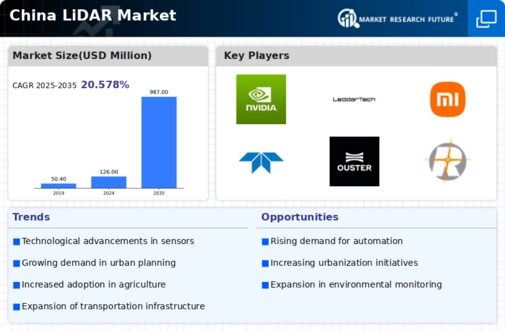Rising Demand in Autonomous Vehicles
The increasing adoption of autonomous vehicles in China is a pivotal driver for the lidar market. As the automotive industry shifts towards automation, the need for advanced sensing technologies becomes paramount. Lidar systems provide high-resolution 3D mapping, essential for safe navigation and obstacle detection. In 2025, the market for autonomous vehicles in China is projected to reach approximately $100 billion, with lidar technology playing a crucial role in this growth. The integration of lidar in vehicles enhances safety features and improves overall driving experience, thereby propelling the lidar market forward. Furthermore, as consumer acceptance of autonomous driving increases, manufacturers are likely to invest more in lidar technology, further stimulating market expansion.
Advancements in Industrial Automation
The trend towards industrial automation in China is a significant driver for the lidar market. Industries are increasingly adopting automation technologies to enhance productivity and efficiency. Lidar systems are utilized in various applications, including robotics, material handling, and quality control. In 2025, the industrial automation market in China is anticipated to surpass $200 billion, with lidar technology being integral to the automation process. The ability of lidar to provide real-time data and facilitate precise measurements enhances operational efficiency, thereby driving demand for lidar solutions. As industries continue to embrace automation, the lidar market is expected to experience substantial growth, fueled by the need for advanced sensing technologies.
Investment in Research and Development
Investment in research and development (R&D) within China is a crucial driver for the lidar market. The government and private sector are increasingly funding R&D initiatives to advance lidar technology and its applications. This investment aims to enhance the performance, accuracy, and affordability of lidar systems, making them more accessible to various industries. In 2025, R&D spending in the technology sector is expected to exceed $150 billion, with a significant portion directed towards lidar innovations. As new technologies emerge, the lidar market is likely to benefit from improved product offerings and expanded applications, fostering further growth and adoption across multiple sectors.
Urbanization and Smart City Initiatives
China's rapid urbanization and the push for smart city initiatives significantly influence the lidar market. As urban areas expand, the demand for efficient infrastructure management and urban planning rises. Lidar technology offers precise data collection for city planners, enabling better decision-making regarding land use, transportation, and environmental monitoring. The Chinese government has allocated substantial funding towards smart city projects, with investments expected to exceed $500 billion by 2030. This financial commitment indicates a robust market potential for lidar applications in urban development. Consequently, the lidar market is likely to benefit from increased demand for high-resolution mapping and monitoring solutions, essential for the successful implementation of smart city frameworks.
Growing Interest in Environmental Monitoring
The heightened focus on environmental sustainability in China is emerging as a key driver for the lidar market. Lidar technology is increasingly employed for environmental monitoring, including forestry management, pollution assessment, and land use analysis. The Chinese government has implemented stringent environmental regulations, necessitating accurate data collection for compliance and monitoring purposes. In 2025, the environmental monitoring market in China is projected to reach $30 billion, with lidar systems playing a vital role in providing high-resolution data for various applications. This growing interest in environmental sustainability indicates a promising future for the lidar market, as organizations seek reliable solutions for effective environmental management.



















Leave a Comment